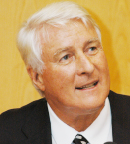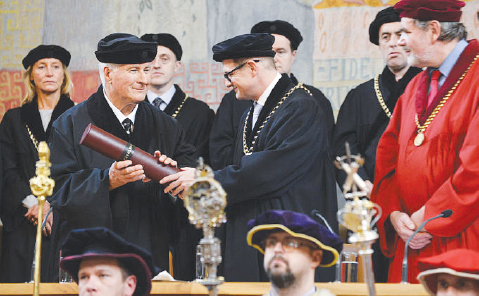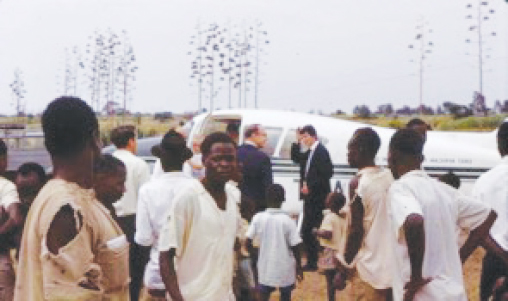
Volker S. Diehl, MD
Volker S. Diehl, MD, the internationally renowned hematologist and researcher, was born in Berlin, Germany, on February 28, 1938—arguably one of the most tumultuous periods in world history. Germany had just invaded Austria, signaling the dark intentions of the Third Reich. In 1943, the air raids of the Americans, British, and French on Berlin became increasingly violent.
“We were woken up three or four times every night by sirens,” revealed Dr. Diehl. “We staggered into the dark cellar, drowsy and freezing. Often, we had to share our beds with other children, who were running in the streets crying and shaking after their homes had been hit by bombs and their parents were dead or buried in the rubble. My father, who was a doctor, would go into the dark streets and give shelter to whomever he could.”
Dr. Diehl described life toward the end of World War II as frightening and chaotic, watching foreign armies march in and occupy Germany. “We had heard terrible stories about Russian soldiers committing rape and other brutal offenses. One day, my father burst into the house and said we had to leave immediately, without taking our belongings, because the Russians were coming!”
Postwar Chaos
After Germany surrendered, Dr. Diehl’s father was banished to an American “internment camp.” His mother was pregnant with the family’s sixth child, and there was very little money or food. When his father returned from the internment camp, he was the only doctor in the town, and his medical services were often paid for in potatoes and peasant sausages. It was a hard life, and, making matters worse, Dr. Diehl described his father as a skilled ENT surgeon who had not only lost his office in Berlin with all the sophisticated instruments, but the war and its aftermath had drained much of his spirit.
- NAME: Volker S. Diehl, MD
- TITLE: Director Emeritus, Internal Medicine, University of Cologne, Cologne, Germany; Chairman, German Hodgkin Lymphoma Study Group
- MEDICAL DEGREE: MD, University of Freiburg Faculty of Medicine, Freiburg, Baden-Württemberg, Germany
- NOTABLE HONORS
- 2016 Honorary Doctor Karls-University Prague (2016)
- Wallace H. Coulter Award for Lifetime Achievement in Hematology (2010)
- “Pioneers in Hematology,” American Society of Hematology 50th Anniversary (2008)
- Hamilton Fairley Award, European Society for Medical Oncology (2005)
- Johann Georg Zimmermann Prize for Cancer Research, Hannover, Germany (2001)
“My parents were so absorbed in daily life and struggling to feed six children that we children had to develop our own will to survive the hardships, helping the farmers, collecting firewood in the forests, and trying to make the most out of life in poverty,” he explained.
Medicine Calls
When Dr. Diehl was still a medical student, his father had a fatal heart attack. He recalled him as a brave man and a good father who had led the family through the terrors of war, “sacrificing himself in the rebuilding of our family, dying too early at the age of 61.”
Dr. Diehl was an excellent student, excelling in old languages like Latin and Greek but without English or French lessons, and after graduating high school, he began studying medicine in Marburg on the Lahn in the late 1950s. He described Marburg as a bucolic, contemplative place nestled in the sleepy Lahn Valley, where he thrived in close academic quarters with several other medical students who would remain lifelong friends and associates.
From Marburg, he moved to Vienna, the city of culture and music, to continue his medical studies. In Vienna, he started and conducted a student chorus and played the first violin in his own quartet.
Money was short, but Dr. Diehl was a veteran of hard times and made the best of it; he hitchhiked with the members of the chorus on weekends to places like Krems in the Wachau, a lush Austrian wine area with a picturesque landscape formed by the Danube River. “We hitchhiked from Vienna and slept in the hay somewhere in the barns of the farmers and sang in the churches and hospitals on Sundays; these experiences have left deep traces in my formation and are some of the most beautiful memories of my life,” said Dr. Diehl.
The evenings were filled with visits at the Vienna Opera and the Hofburg Theater. Medicine played an important but sometimes a neglected role.
“However, I’ll never forget the lively and realistic lectures by Professor Hoff, the famous neurologist and psychiatrist, and Professor Antoine, the gynecologist, both idiosyncratic professors of the old academic style of the 19th and 20th centuries. These men of deep self-belief proclaimed their messages as stone-carved truths and tolerated no contradiction.”
After a year in Vienna, Dr. Diehl returned to Germany to attend the University of Freiburg Faculty of Medicine. Founded in 1457, the Faculty is one of Germany’s oldest and most highly regarded institutions. He flourished in the esteemed university and had many unforgettable experiences with people who shaped his life and world views.
“While at the Children’s Hospital, I loved working with sick children and at that time [1966] thought I might become a pediatrician.”— Volker S. Diehl, MD,
Tweet this quote
After 3 years, Dr. Diehl began running the gauntlet of rigorous final exams—25 in full—that run from April to November, filling most of his classmates with dread. Dr. Diehl finished the last exam on a fateful day, November 22, 1963. “I remember this date so well because I was in a phone booth about to call a girlfriend when a man yanked open the door and shouted, ‘Have you heard, John Kennedy has just been shot!’ The dreadful news ended in a tearful drunk with friends!” shared Dr. Diehl.
Relocating to the United States
At the end of 1964, Dr. Diehl went back to Berlin and completed his gynecologic studies at the gynecologic clinic in the Westend Hospital. From the end of 1965 to May 1966, he completed his doctoral thesis in Freiburg and at the same time worked as an assistant to Professor Künzer in the Children’s Hospital. “While at the Children’s Hospital, I loved working with sick children and at that time thought I might become a pediatrician,” Dr. Diehl commented.

Dr. Diehl with his wife, Antje, in New Zealand
Despite his academic and clinical successes, Dr. Diehl felt the need to expand his horizons. In a turn of luck, two German virologists, Werner and Gertrude Henle, in the States offered him an opportunity to do a research fellowship in Philadelphia on a grant by the National Cancer Institute. In 1966, Dr. Diehl left for the United States aboard the TS Bremen, one of Germany’s largest passenger liners.
During the 6-day voyage, the vessel was caught in Hurricane Alma, a massive storm that put the ship and its 1,200 passengers in distress. According to Dr. Diehl, everyone on board “vomited their souls out of their bodies.” However, the intrepid Dr. Diehl and his companion, Jürgen Heraeus, had devised a sophisticated antinausea that kept them in fine trim.
“Jürgen and I became the ship’s table tennis champions, defeating two excellent Japanese ping-pong pros because their short arms could not reach the balls due to the enormous rolling motion of the ship,” said Dr. Diehl.
His sponsors, Drs. Werner and Gertrude Henle, graciously introduced him to his new position at the laboratory in Children’s Hospital. Werner Henle, normally a generous and friendly man, was not amused about the fact that Dr. Diehl could not speak a word of English! “Volker, I shall not speak with you until you have learned to address me in English,” Werner, rather seriously told Dr. Diehl. That meant, I had to learn English rather quickly!
But as usual, adventure followed Dr. Diehl. First came the language shock, then the culture shock of city life in a country with very different customs and social norms than his. Then, the neighborhood where Dr. Diehl lived and walked to work was engulfed in violent race riots in 1966. But it was also a time when Dr. Diehl’s career accelerated.

Dr. Diehl with his son, Johannes, in the Austrian Mountains
“My first task was to try to transform normal lymphocytes with Epstein-Barr virus (EBV), and I was the first to succeed, transforming umbilical cord blood cells to permanently growing immortalized cells in vitro, in 1966,” he said. While working in the Henles’ laboratory in 1967, Dr. Diehl discovered the role of EBV in infectious mononucleosis with serendipity playing a role, as a young technician in the laboratory called in sick one day.
“Gertrude Henle was always mad if someone didn’t come to work, so I pleaded with the young woman to come in. When she arrived, she was very sick, and I immediately diagnosed infectious mononucleosis.” Fortunately, this young woman was the only person in the lab who had been EBV-negative. Dr. Diehl cultured her blood, now positive for EBV, and made the connection that EBV was the causative agent in mononucleosis.
‘The Most Exciting Year of My Whole Life’
Dr. Diehl explained that the endemic African Burkitt lymphoma occurred in about 1 in 30,000 inhabitants in the malaria-infested regions of East Africa; a western non–EBV-related Burkitt-like lymphoma occurred in 1 in 10 million people outside Africa. “The question came up, does infectious mononucleosis occur at all or even more often in the Burkitt area?” said Dr. Diehl.
“I did 427 cultures before I had the first cell line of Reed-Sternberg cells. The 428th attempt became what is now the L428 cell line.”— Volker S. Diehl, MD
Tweet this quote
He continued: “Dr. Werner Henle was very excited about this question and applied for a grant at the American Cancer Society to get support and help to answer it. The grant was accepted, and Werner asked me to take over the task to find out the prevalence of infectious mononucleosis around the Burkitt cases in East Africa. In March 1968, I flew from Philadelphia to Nairobi and started the most exciting year of my whole life!”
“Dr. Peter Clifford, a typical British gentleman, welcomed me warm-heartedly and gave me the chance to do my studies on his ENT ward. On top of this, Dr. Theo Hanegraaff, Director of the Dutch Research Center, located on the compound of Kenyatta National Hospital, offered me a laboratory space for my scientific work: tissue cultures, preparation of tumor material, and serum collections. There was also ample space with deep-freezing facilities,” said Dr. Diehl.
Since Dr. Diehl’s mission was to find out about the prevalence of infectious mononucleosis around Burkitt cases, he wanted to come as close as possible to the endemic area around Lake Vicoria. He’d picked up an old Ford Taurus, but the distance by car was around 1,000 miles, driving time 15 to 30 hours, which was untenable.
“So I called the Flying Doctor Service in Nairobi and asked Mikel Wood, founder and chief of this organization, whether they would give me the opportunity to fly with them and in exchange I would help them as an assistant in the surgical theaters. They immediately agreed, happy for some medical assistance, since they were short of doctors,” said Dr. Diehl. He added: “Before my first trip down to Uganda, I called Denis Burkitt and arranged to meet at the Mulago Hospital, as he was the key person to tell me where I could find the most dense area with Burkitt children.”
Drs. Diehl and Burkitt got along famously, both deeply religious men committed to bettering humanity. Using the Flying Doctor Service, the two doctors visited hospitals in Kenya, Tanzania, Uganda, and Sudan. “Dr. Burkitt showed me the places where most of these Burkitt lymphoma cases occurred, and I started a serum collection to find out whether the children who get Burkitt lymphoma are EBV-negative or EBV-positive before they get the disease. Denis Burkitt was a great man, and it was the greatest year of my life; I even learned to fly!” Dr. Diehl shared.

Dr. Diehl at Charles University in Prague, where he was awarded an honorary degree in 2016
In January 1969, Dr. Diehl flew back to the United States, making small stops in India, Cambodia, Japan, Hawaii, San Francisco, and Philadelphia. “I finished my work and said goodbye to all my friends I had made in the past years,” he said.
Hodgkin Lymphoma
While in Nairobi, Dr. Diehl had met two Swedish immunologists, Drs. George Klein and Yerzy Einhorn, who invited him to work with them in Stockholm. “I went to Sweden and worked at the Karolinska Institute as a radiotherapist. Until this time, I had never seen a Hodgkin’s patient,” said Dr. Diehl.
In Sweden, Hodgkin lymphoma was prevalent, primarily in younger adults. “There were these beautiful young children with Hodgkin lymphoma, and at that time about 60% still died when they had advanced disease. The cure rate was 60% to 70% with radiation for localized disease, but there was very little hope for patients with advanced disease,” he said.
The experience fueled his desire to unlock the “black box” of Hodgkin lymphoma. “At the time, we didn’t know if it was an inflammation, an infectious disease, or a real malignant lymphoma.” scientific undertaking would take more than a decade of assiduous lab work.
“I did 427 cultures before I had the first cell line of Reed-Sternberg cells. The 428th attempt became what is now the L428 cell line—the master cell line on which most of the molecular-genetic experiments have been performed globally. People always ask what it was like to fail 427 times, and I say, well I learned by doing it, and there were times I thought about quitting, but the stakes were too high,” he added.
Fighting the Good Fight
Dr. Diehl eventually returned to Germany and spent 20 years working to improve the outcomes of patients with Hodgkin lymphoma. Although the survival curve was impressive, Dr. Diehl saw an unmet need he wanted to address.

Dr. Diehl during a trip to Uganda with the Flying Doctor Service
In 1978, he founded the German Hodgkin Study Group, the largest Hodgkin lymphoma group in the world. By the work of this group, in 40 years and 7 generations of successive studies with more than 20,000 patients, the cure rate of patients with advanced stages of Hodgkin lymphoma has improved from 40% to more than 90% in 2018!
“In 1997, we started an integrative oncology center for patients at the University of Cologne, called Lebenswert, which means “worth living. We have psychologists who specialize in psycho-oncology, a dance group, a choir, a theater group, a Nordic walking group, and more,” said Dr. Diehl.
A Rich Life
In 2004, after 21 years of intensive work and management of the Department of Internal Medicine at the University Hospital in Cologne, he had to leave his position as Head of the Clinic because he reached the retirement age limit. Considering himself a person of the world, Dr. Diehl travels extensively and enjoys his large family. He has won numerous awards, but his illustrious career is judged more by his pioneering work, which has saved countless lives and reduced unnecessary suffering.
“When I look back on my life now, hopefully not quite at the end, I have to say it was a rich, full life, and there were many great moments, great people whom I met and who became friends, sponsors, tutors, companions, and admonishers,” said Dr. Diehl. ■

